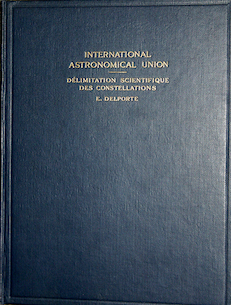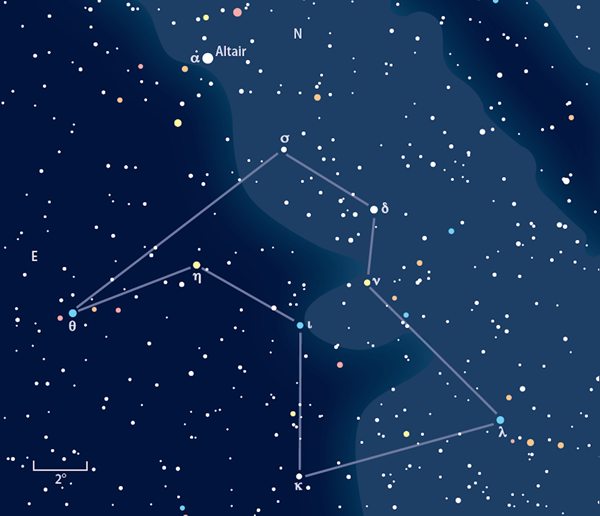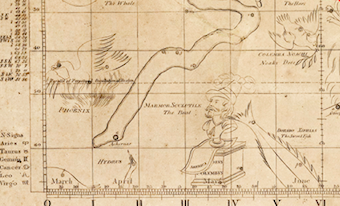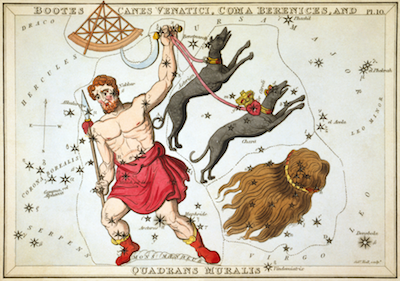Still, when I’m at a star party or observing on my own, I often track down a couple of these defunct patterns because it’s fun. And I have the best time when friends join in. If you’d like to try your hand at this, too, read on.
Background
The first star maps and globes had fewer than 50 constellations, yet despite that relatively small number, some of those have not survived. The most notable is the truly massive former constellation Argo Navis, the legendary ship that carried Jason and the Argonauts in search of the Golden Fleece.
Argo Navis is the only example of a star pattern that fell into disuse for purely practical reasons: It was simply too big. So, around 1750, French astronomer Nicolas Louis de Lacaille divided it into the constellations Carina, Puppis, and Vela. Sometimes the constellation Pyxis the Compass also gets lumped into this grouping as well, but this is incorrect. In fact, Lacaille himself pictured Argo Navis as a complete ship with Pyxis just to its north on a celestial map he produced in 1752.
The use of designations for Argo Navis’ stars was so ingrained that, when it was rent asunder, the original set of Greek letters was retained, with no additional ones added. As a result, Puppis and Vela have no Alpha or Beta stars. Those letters stayed with stars that now form Carina.
Almost every other constellation that’s gone the way of Argo Navis has vanished because of non-acceptance by the community of astronomers at large. Many of those star groups were meant to honor the patron or monarch of the astronomer who named them. Needless to say, outside the boundaries of the relevant country, those tributes were not well received. A similar situation occurred in 1781, when a row developed after Sir William Herschel attempted to name his newly discovered planet “Georgium Sidus,” or “George’s Star,” after George III of England. That British-leaning name didn’t stick, so it was Uranus ever after.
But just because we categorize a constellation as extinct doesn’t mean we have no record of it. Star maps exist that show these figures. We know which stars formed them. And, most importantly to observers, you can still go outside and find them. I’ve listed 12 of my favorites here (in alphabetical order), but there are at least a hundred others a little research will lead you to. Have fun!
Antinoüs
The great German-Flemish mapmaker Gerardus Mercator placed this figure on a celestial globe he created in 1551. He formed it from the stars Eta (η), Theta (θ), Sigma (σ), Delta (δ), Nu (ν), Lambda (λ), Kappa (κ), and Iota (ι) Aquilae. The stars range in brightness from magnitude 3.2 (Theta) to magnitude 5.2 (Sigma), so spotting them requires a reasonably dark site.
The figure represented the servant/lover of the Roman Emperor Hadrian. According to one account, Antinoüs drowned himself in the Nile River, believing that, with this sacrifice, he would prolong his master’s life. After his death, he was worshipped as both a god and a hero.
Apes/Lilium/Musca Borealis
Three constellations, all extinct, have occupied the same tiny area in the northern part of Aries the Ram. You can find — pick a name — by locating 33 Arietis, 35 Ari, 39 Ari, and 41 Ari. They range in magnitude from 3.6 to 5.3.
The Dutch-Flemish mapmaker Petrus Plancius got the ball rolling by putting Apes the Bee on his 1612 star chart. In 1679, French architect Augustin Royer used the same stars for Lilium the Fleur-de-lis. About a decade later, Polish astronomer Johannes Hevelius re-christened that area Musca, although later mapmakers who used the figure called it Musca Borealis to distinguish it from the far-southern constellation Musca the Fly.
The Battery of Volta
British physician and Egyptologist Thomas Young designated this constellation in 1806 to honor an important invention by Alessandro Volta: the electric battery. There’s not much to it, however. It’s just two stars: 1 Pegasi, which glows at magnitude 4.1, and 9 Pegasi, which is ever so slightly fainter at magnitude 4.3. Maybe Young decided to represent just the battery’s terminals?
In Greek mythology, Cerberus was the three-headed hound that guarded the gates of Hades, but not against intruders. Instead, he was there to prevent the dead from leaving. Hevelius included Cerberus as part of Firmamentum Sobiescianum, sive Uranographia, totum Coelum Stellatum, a collection of star maps he created in 1687.
You can find Cerberus midway between the head of Hercules and the head of Cygnus, made primarily of the stars 93, 95, 96, 102, and 109 Herculis. Do note that the brightest of these stars, 109 Her, glows at magnitude 3.9. I’ve found that the best way to see this group is to use tripod-mounted binoculars. You don’t need much magnification, but choose binoculars with a field of view at least 7.5° wide (the distance between 93 Her and 109 Her).
Felis
French astronomer Jérôme Lalande suggested this constellation in 1799 because there was no cat in the sky. Apparently, he was thinking house cat, because three constellations — two lions and a lynx — already represented the feline family. It made its initial appearance in the star atlas Uranographia sive Astrorum Descriptio, created by German astronomer Johann Elert Bode in 1801.
You can find Felis — and I warn you, its stars are faint — by heading 30° due south of Regulus (Alpha [α] Leonis), and trying to make a cat out of magnitude 3.8 Mu (μ) Hydrae and a few similarly dim stars nearby. You’ll see the constellations Corvus and Crater. Get a sense of their similar sizes. Felis lies on the western side of Crater opposite Corvus.
Gladii Electorales Saxonici
German astronomer Gottfried Kirch introduced this constellation — a pair of crossed swords — in 1684 as a political move. He hoped to win the patronage of Johann Georg III, Elector of Saxony.
The star pattern consists of nine stars between magnitudes 3.7 and 5.2. The area they’re in is bounded by Arcturus (Alpha Boötis), Unuk al Hai (Alpha Serpentis), Zubeneschamali (Beta [β] Librae), Mu Virginis, and Tau (τ) Virginis. Finding this location is easy. Making Gladii Electorales Saxonici out of its stars is not.
Marmor Sculptile
I wanted to include a few defunct constellations from the Southern Hemisphere; my first is a figure that represents the bust of Christopher Columbus. American mapmaker William Croswell placed this star pattern on A Mercator Map of the Starry Heavens, which he produced in 1810. To form Marmor Sculptile, Croswell simply used the existing constellation Reticulum with a few stars from neighboring Horologium.
In 1822, Scottish writer Alexander Jamieson introduced this constellation in A Celestial Atlas. To create it, he used stars in far-eastern Hydra and western Libra. But he wasn’t the first to appropriate the stars in this area.
In 1776, French astronomer Pierre Charles Le Monnier created Turdus Solitarius, the Solitary Thrush, using no less than 41 stars between 3rd and 9th magnitude. You can find either of these birds of yesteryear by locating a curved line of five stars: 4 Librae and 54, 55, 56, and 57 Hydrae. Binoculars will make your task much easier because the brightest of these luminaries glows at only magnitude 5.2.
Quadrans Muralis
French astronomer Jérôme Lalande invented this constellation in 1795 to commemorate the wall-mounted quadrant at l’École Militaire Observatory in Paris. It appeared that year (as “Le Mural”) in Atlas Céleste by Jean Fortin. Johann Bode changed the constellation’s name to Quadrans Muralis when he included it in his 1801 star atlas.
In the sky, locate the area that starts midway between magnitude 3.5 Nekkar (Beta Boötis) and magnitude 4.6 Chi (χ) Herculis and extends about 10° to the north. If this constellation’s name rings a bell, you probably have heard it before. The radiant of the Quadrantid meteor shower, which peaks around January 4 each year, lies within its (former) boundaries.
Robur Carolinum
None other than the great Edmund Halley created my second extinct southern-sky constellation. In 1679, he used some seriously bright stars in Argo Navis (now also gone) to commemorate the Royal Oak where the King of England, Charles II, supposedly hid from the army of Oliver Cromwell after the Battle of Worcester in 1651. The brightest star of Robur Carolinum was magnitude 1.7 Miaplacidus (Beta Carinae).
Tubus Herschelii Major and Tubus Herschelii Minor
My final entry is a pair of defunct constellations. Hungarian astronomer and Jesuit priest Maximilian Hell formed both in 1789 to honor Sir William Herschel’s discovery of Uranus. Tubus Herschelii Major commemorated Herschel’s 20-foot telescope, while Minor represented his 7-foot telescope.
Hell placed the larger constellation in Auriga and the smaller between Taurus and Orion. He did this so they would lie on either side of the point in Gemini where Herschel found the planet. Later maps combined the two into Telescopium Herschellii. To find it, head outdoors and locate Castor (Alpha Geminorum). Telescopium Herschelii occupies a large region north of that star in Lynx and Auriga.
The ancient sky awaits
In Star Trek II: The Wrath of Khan, Dr. Leonard McCoy eulogizes Mr. Spock in a way that can apply here: “He’s not really dead as long as we remember him.” So, these constellations really aren’t extinct as long as we observe them. I encourage you to head out on the next clear night and see if you can locate one of these obscure star figures that meant so much to so few.













